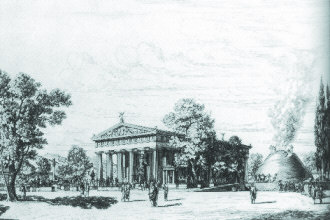Olympia is located 10km inland in the territory of
Elia in the northwestern
Peloponnese, just near the confluence of Alpheios with the river Kladeos.
Peloponnesos, where Olympia lies, was considered to be the island of Pelops, the
mythical figure whose life was traditionally linked to the site of Olympia.

|
|
Near the point where the two rivers meet, there rises a low hill covered with pines. This bears the name of Kronos, the father of Zeus, and surrounds the flat area of the shrine, the name of which was "Altis", meaning grove (alsos) in the Elian dialect.
The ancient writers tell us that Altis used to be shaded with olive-trees. Greeks honored Zeus and other deities at altars located in the Altis. The cults of Kronos, Rhea, Gaia, Eileithyia, Themis and Idaian Herakles were also worshiped at Olympia since the earlier times. From the sixth century and on, the Altis was adorned with temples, elaborate shrines, and statues. The Altis was the center of all religious activities during the Olympic festival.

The site of Olympia developed from a local cult center to a
Pan-hellenic
sanctuary throughout the course of the centuries.

In the Geometric and Archaic periods (10th-6th centuries BC), the site was reorganized to meet the increasing needs created by the visitors of the site. In the early 6th century BC, the first temple, dedicated to Hera, was erected. A series of structures with votive offerings were dedicated to the sanctuary by various Greek cities, in of which many were wealthy Greek colonies.
In the Classical era (5th and 4th centuries BC), the sanctuary complex was reorganized to accommodate the most magnificent temple of the site: the temple of Zeus, containing the most famous cult statue of Zeus, made by the famous sculptor Pheidias. The site was supplied with a number of new secular buildings and athletic facilities.
In the late Classical (4th century BC) and Hellenistic periods the site was decorated with buildings dedicated by Philip II of Macedonia, father of Alexander the Great, and other wealthy donors. New elaborated practice areas, such as the Gymnasium and the Palaistra, were erected.
In the Roman
period the sanctuary acquired an international fame and enjoyed imperial
benefits. Following the political crisis in the late Roman
period, the decline of Olympia was accelerated. In
|
Importance
| |
|
|
|